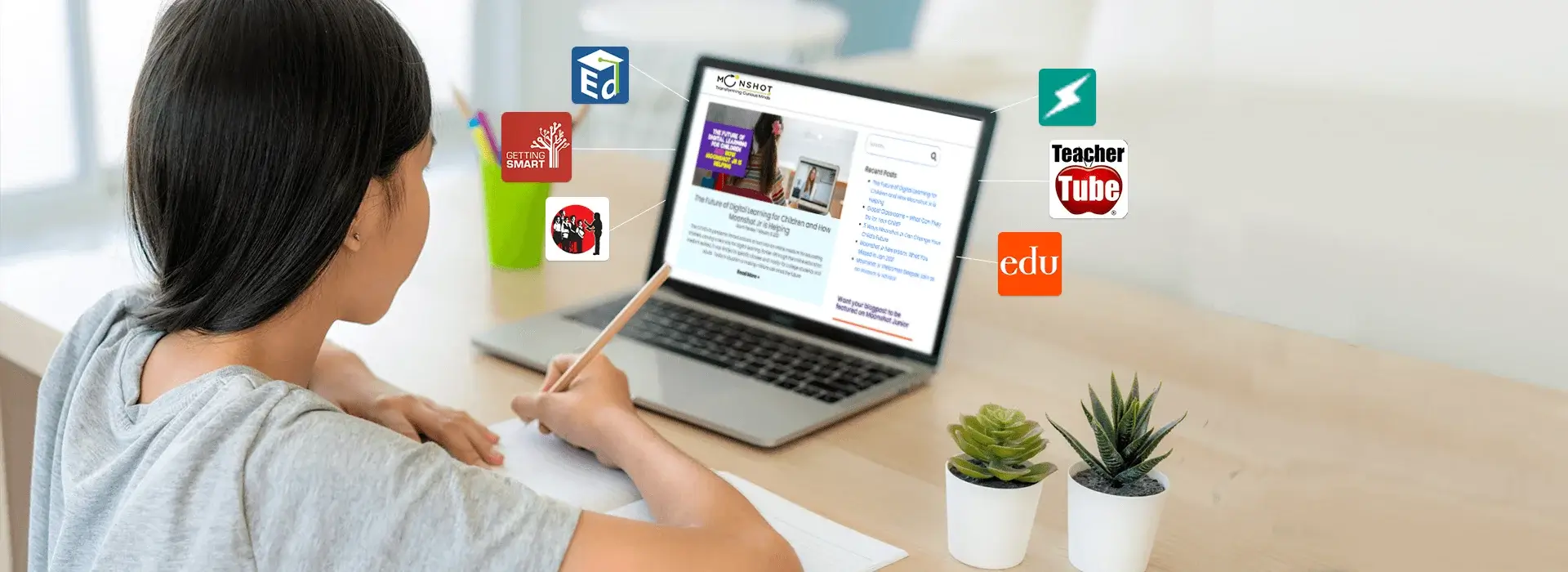
Moonpreneur
Update: This article was last updated on 19th April 2023 to reflect the accuracy and up-to-date information on the page.
Many parents often wonder if video games have educational value and if they should allow their children to play them. This report can be an eye-opener for you. According to a report by MarketsAndMarkets, the Game-Based Learning Market is worth $11.0 billion in 2021 and is expected to grow to $29.7 billion by 2026, with a CAGR of 21.9%.
Educational video games can make boring history lessons interesting and simplify difficult math concepts. These games aim to teach players new skills and concepts in a fun and engaging way, making them suitable for both classroom settings and home use.
Top 5 Educational Video Games
| Game | Age | Skills |
|---|---|---|
| Reader Rabbit | 3-7 Years | Reading + language skills |
| LittleBigPlanet | 3-18 Years | Creativity |
| Scratch | 6-16 Years | Programming |
| Minecraft | 10+ Years | Creativity, problem-solving |
| Big Brain Academy | 6+ Years | Cognitive Skills |
The next difficult task is to select an appropriate game for your child. Here are the top 5 educational video games for kids –
Must Try!! Moonpreneur Career Quiz
1) Reader Rabbit: Reader Rabbit is a series of educational video games that are designed to teach reading and language skills to young children. The games use a variety of interactive activities, such as puzzles, games, and songs, to teach reading, phonics, and other language skills.
The games take place in the fictional world of “Rabbitville”, following the adventures of a character named Reader Rabbit as he learns and grows.
Age: 3-7 years
Skills: Reading and language
Platforms: Computers, tablets, and smartphones.
2) LittleBigPlanet: Developed by Media Molecule and published by Sony Computer Entertainment, the games are known for their emphasis on creativity and user-generated content, as players can create and share their own levels and game elements.
In this game, players control a character called Sackboy or Sackgirl, who can run, jump, and interact with the environment to solve puzzles and progress through the game. The games are set in a series of interconnected levels, and players must navigate through each level to reach the end.
The games are known for their colorful and imaginative worlds, and they have received numerous accolades for their design and gameplay. Generally, it is suitable for all age groups, but younger children may need assistance with some of the more challenging levels.
Age: 3- 18 years
Skills: creativity and user-generated content
Platform: PlayStation 3, PlayStation 4, and PlayStation Vita.
3) Scratch: A free, online programming language, Scratch allows users to create and share interactive games, animations, and other projects using blocks of code.
The Scratch website includes a variety of resources and tutorials to help users get started with programming, including step-by-step guides, sample projects, and a community forum. Developed by the Lifelong Kindergarten group at the Massachusetts Institute of Technology (MIT), Scratch is designed to be easy to use, and it is a popular choice for educators looking to introduce students to programming.
In addition, users can also use Scratch to create interactive stories, music and art projects, and simulations. Scratch projects can be shared with the Scratch community, or they can be shared with others using a link or embedded on a website.
Age: 6-16 years
Skills: Programming
Platform: Laptops and desktops + App on Windows and Mac devices
4) Minecraft: The game allows players to explore, build, and create in a virtual world made up of blocks. In Minecraft, players can gather resources, craft items, and build structures using a variety of different materials, such as wood, stone, and metal.
Developed by Mojang Studios, the game has two main modes: survival mode, where players must gather resources and fend off dangers such as monsters, and creative mode, where players have access to unlimited resources and can build and create without any constraints.
With the power of imagination and problem-solving, Minecraft provides children with an opportunity to explore their creative capabilities while strengthening essential life skills. It not only helps them tackle virtual tasks but encourages them in tackling real-world challenges too!
Age: 10+ years
Skills: Creativity, problem-solving
Platform: PC, Xbox, PlayStation, Nintendo Switch
Recommended Reading: Why is Minecraft So Popular?
5) Big Brain Academy: This is a puzzle-based educational video game developed and published by Nintendo. It was released for the Nintendo DS handheld console in 2005.
There are 15 activities divided into 5 groups that test the players’ mental abilities in a variety of areas, including logic, memory, math, and analysis. The game tracks players’ progress and assigns them a “brain weight” based on their performance, intending to increase their brain weight over time. It improves cognitive skills.
It is suitable for players of all ages, although it may be more challenging for younger children. The game received generally positive reviews upon its release and has been praised for its engaging gameplay and educational value.
Age: 6+
Skills: Cognitive skills
Platforms: Platform(s): Nintendo DS, Wii, Nintendo Switch
One would ask the question of whether there are any benefits to playing an educational video game.
Surprisingly enough, Yes!!
In a case-control study of 2217 children aged 9-10, published in JAMA Network Open Journal on October 24th, 2022, nearly 3 hours of video game play was associated with increased cognitive performance compared to non-players. This improved cognitive function can enhance activities such as reading, attention, thinking, learning, and memory retention.
Benefits of playing video games:
Improved problem-solving skills: Many educational video games require players to think critically and solve problems that develop problem-solving skills.
Enhanced Learning: It is an effective way of learning new concepts and information, as they often use interactive and engaging techniques to present material.
Increased motivation: Video games are designed to be fun and engaging, which can boost motivation and inspire players to learn more.
Improved concentration and focus: Educational video games can improve concentration and focus.
Enhanced creativity: Educational video games promote creative thinking and problem-solving and even foster innovation.
Moonpreneur is also offering a free $10 Minecraft e-gift card for attending their game development or robotics trial class for kids between the ages 7-16 years.
Minecraft is one of the most popular games among kids, and Moonpreneur is now turning this fun gameplay into an opportunity to learn how to code. Minecraft Coding course will help kids learn the skill of coding the fastest and in the most fun way ever possible! Book a free class today!

















These top 5 kid-friendly instructional video games appear to strike a fantastic balance between enjoyment and knowledge. It’s fantastic to observe how technology may be used to advance kids’ education.
Math Blaster is also a fantastic game as, in my experience as a teacher, it has completely transformed my classroom! It encourages flexible study while energizing math. My students enjoy the challenges and have gained confidence in their mathematical abilities.
Do these games encourage player interaction or social engagement, and if so, how is this made possible?
Yes, educational games generally promote teamwork and shared learning experiences through multiplayer modes, cooperative gaming, online forums, and in-game communication features.
Although Reader Rabbit is a well-liked educational game, one disadvantage is that its activities may feel shallow and uninteresting after one point, which might make some kids lose interest or feel bored.
Add LeapFrog LeapLand Adventures to your list, as it is an engaging and immersive instructional game. It takes kids on a fascinating trip through an exciting virtual environment while providing a variety of educational challenges and activities. The game covers various topics, including math, reading, science, and problem-solving.
I am not completely satisfied with the list you have mentioned, as there are few more educational games that promote learning, inspire children to learn, assist them in problem-solving, and enhance concentration and focus. The following are ten examples. World RescueAnimal Jam ClassicEndless AlphabetCities: SkylinesProdigyWordscapesDemocracy SeriesDiscovery Tour by Assassin’s CreedCivilization 6Nancy Drew MysteriesEducational games can be a great way for kids to learn and grow, but it’s important to make sure the games they play match their needs and interests. I also think it’s important to find a balance between instructional games and other activities.
Does gaming help to develop kids’ brains?
It looks like your little one might not be as bad as you think! According to a new study, kids can actually benefit from playing video games. But there’s still some concern that playing too much can lead to sadness and bad behavior. That’s why it’s best to stick to the 1-2 hours per day recommended by the AAP.
Although educational video games can be an enjoyable and interesting way for youngsters to learn, they have some disadvantages. Frame time is one of the most important things. However, playing educational video games can add to the daily two-hour usage time a child should adhere to. In addition, certain educational video games may contain violent content that may sensitize young players. Not all educational video games are created equal, and some may not fit the curriculum or appeal to all children. Finally, traditional teaching methods should not be replaced by educational video games.